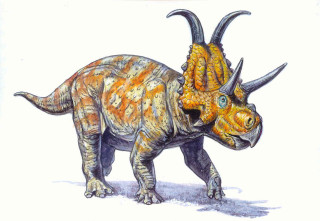Diabloceratops eatoni

Name: Diabloceratops eatoni
(Pronunciation: dee-OB-low-sarah-tops ee-TON-eye)
Age: Late Cretaceous (~79.5 million years ago)
Where It's Found in Utah: Kane and Garfield counties, Grand Staircase-Escalante National Monument, Utah.
Geologic Formation: Wahweap Formation (middle mudstone member)
Classification: Ornithischia - Ceratopsia - Ceratopsidae - Centrosaurinae
Description: With its big round nose, long horns, and spiked frill, Diabloceratops is strange looking, even for a dinosaur. Unlike most other centrosaurine ceratopsians, Diabloceratops had long horns above its eyes and a short nose horn, similar to more well-known chasmosaurines such as Triceratops, Kosmoceratops, and Utahceratops. This animal also had a deep snout compared to other members of this group of horned dinosaurs. Like all ceratopsians, Diabloceratops had a beaked mouth for feeding on plants. The ‘Diablo’ in this dinosaur’s name comes from the Latin word for ‘devil’, which is a reference to the large pair of upward and sideways curving horns on the back of its frill.
Why It’s a Top NHMU Dinosaur: The only known specimen of Diabloceratops was discovered in 1998 and excavated in 2000 by the Utah Geological Survey, Natural History Museum of Utah, and Utah Friends of Paleontology. The specimen resides here at the NHMU! It is the oldest known and one of the most primitive centrosaurine dinosaurs and was the first member of this group to be discovered south of Montana. This new species may be a primitive ancestor of the well-known ceratopsians Triceratops and Styracosaurus. Paleontologists know little about the early evolution of ceratopsians. While we have over 30 species from between 78 and 65 millions years ago, only three species have been discovered from between 90 and 78 million years ago. This makes Diabloceratops – a dinosaur unique to Utah – an important addition to our knowledge of the evolution of horned dinosaurs.
Where Can I See It?: The Past Worlds Gallery at the Natural History Museum of Utah.
Suggested Reading/References:
Kirkland, J. I., and D. D. DeBlieux. 2007. New horned dinosuars from the Wahweap Formation, Grand Staircase-Escalante National Monument, southern Utah. Utah Geological Survey Notes 39:4-5.
Kirkland, J. I., and D. D. DeBlieux. 2010. New centrosaurine ceratopsians from the Wahweap Formation, Grand Staircase-Escalante National Monument, southern Utah; pp. 117-140 in M. J. Ryan, B. J. Chinnery-Allgeier, and D. A. Eberth (eds.), New Perspectives on Horned Dinosaurs: The Royal Tyrrell Museum Ceratopsian Symposium. Indiana University Press, Bloomington.
Credits:
Image: © 2009 Mark Hallett, Mark Hallett Paleoart
Author: Joshua Lively, Paleontology Graduate Student at the Natural History Musuem of Utah (2012)